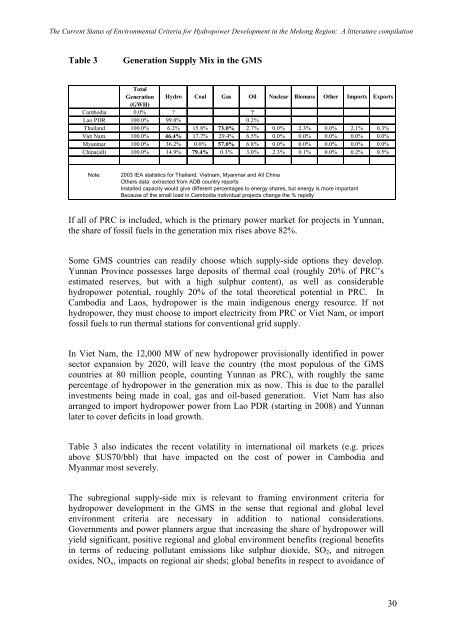Environmental Criteria for Hydropower in the Mekong Region - WWF
Environmental Criteria for Hydropower in the Mekong Region - WWF
Environmental Criteria for Hydropower in the Mekong Region - WWF
Create successful ePaper yourself
Turn your PDF publications into a flip-book with our unique Google optimized e-Paper software.
The Current Status of <strong>Environmental</strong> <strong>Criteria</strong> <strong>for</strong> <strong>Hydropower</strong> Development <strong>in</strong> <strong>the</strong> <strong>Mekong</strong> <strong>Region</strong>: A litterature compilation<br />
Table 3 Generation Supply Mix <strong>in</strong> <strong>the</strong> GMS<br />
Total<br />
Generation<br />
(GWH)<br />
Hydro Coal Gas Oil Nuclear Biomass<br />
O<strong>the</strong>r Imports Exports<br />
Cambodia 0.0% ? ?<br />
Lao PDR 100.0% 99.8% 0.2%<br />
Thailand 100.0% 6.2% 15.8% 73.0% 2.7% 0.0% 2.3% 0.0% 2.1% 0.3%<br />
Viet Nam. 100.0% 46.4% 17.7% 29.4% 6.5% 0.0% 0.0% 0.0% 0.0% 0.0%<br />
Myanmar 100.0% 36.2% 0.0% 57.0% 6.8% 0.0% 0.0% 0.0% 0.0% 0.0%<br />
Ch<strong>in</strong>a(all) 100.0% 14.9% 79.4% 0.3% 3.0% 2.3% 0.1% 0.0% 0.2% 0.5%<br />
Note: 2003 IEA statistics <strong>for</strong> Thailand, Vietnam, Myanmar and All Ch<strong>in</strong>a<br />
O<strong>the</strong>rs data extracted from ADB country reports<br />
Installed capacity would give different percentages to energy shares, but energy is more important<br />
Because of <strong>the</strong> small load <strong>in</strong> Cambodia <strong>in</strong>dividual projects change <strong>the</strong> % rapidly<br />
If all of PRC is <strong>in</strong>cluded, which is <strong>the</strong> primary power market <strong>for</strong> projects <strong>in</strong> Yunnan,<br />
<strong>the</strong> share of fossil fuels <strong>in</strong> <strong>the</strong> generation mix rises above 82%.<br />
Some GMS countries can readily choose which supply-side options <strong>the</strong>y develop.<br />
Yunnan Prov<strong>in</strong>ce possesses large deposits of <strong>the</strong>rmal coal (roughly 20% of PRC’s<br />
estimated reserves, but with a high sulphur content), as well as considerable<br />
hydropower potential, roughly 20% of <strong>the</strong> total <strong>the</strong>oretical potential <strong>in</strong> PRC. In<br />
Cambodia and Laos, hydropower is <strong>the</strong> ma<strong>in</strong> <strong>in</strong>digenous energy resource. If not<br />
hydropower, <strong>the</strong>y must choose to import electricity from PRC or Viet Nam, or import<br />
fossil fuels to run <strong>the</strong>rmal stations <strong>for</strong> conventional grid supply.<br />
In Viet Nam, <strong>the</strong> 12,000 MW of new hydropower provisionally identified <strong>in</strong> power<br />
sector expansion by 2020, will leave <strong>the</strong> country (<strong>the</strong> most populous of <strong>the</strong> GMS<br />
countries at 80 million people, count<strong>in</strong>g Yunnan as PRC), with roughly <strong>the</strong> same<br />
percentage of hydropower <strong>in</strong> <strong>the</strong> generation mix as now. This is due to <strong>the</strong> parallel<br />
<strong>in</strong>vestments be<strong>in</strong>g made <strong>in</strong> coal, gas and oil-based generation. Viet Nam has also<br />
arranged to import hydropower power from Lao PDR (start<strong>in</strong>g <strong>in</strong> 2008) and Yunnan<br />
later to cover deficits <strong>in</strong> load growth.<br />
Table 3 also <strong>in</strong>dicates <strong>the</strong> recent volatility <strong>in</strong> <strong>in</strong>ternational oil markets (e.g. prices<br />
above $US70/bbl) that have impacted on <strong>the</strong> cost of power <strong>in</strong> Cambodia and<br />
Myanmar most severely.<br />
The subregional supply-side mix is relevant to fram<strong>in</strong>g environment criteria <strong>for</strong><br />
hydropower development <strong>in</strong> <strong>the</strong> GMS <strong>in</strong> <strong>the</strong> sense that regional and global level<br />
environment criteria are necessary <strong>in</strong> addition to national considerations.<br />
Governments and power planners argue that <strong>in</strong>creas<strong>in</strong>g <strong>the</strong> share of hydropower will<br />
yield significant, positive regional and global environment benefits (regional benefits<br />
<strong>in</strong> terms of reduc<strong>in</strong>g pollutant emissions like sulphur dioxide, SO2, and nitrogen<br />
oxides, NOx, impacts on regional air sheds; global benefits <strong>in</strong> respect to avoidance of<br />
30

















